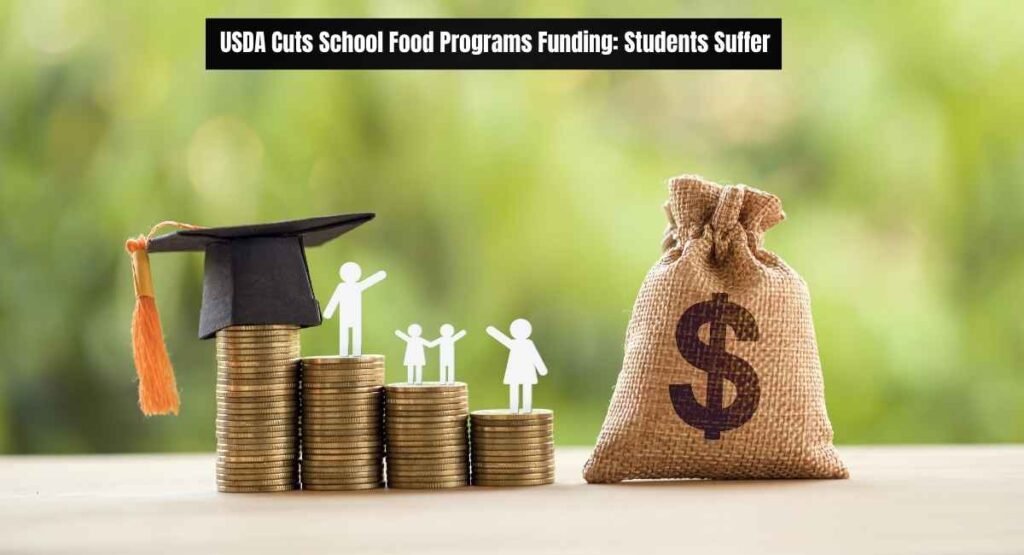USDA Cuts School Food Programs Funding: A National Wake-Up Call
Overview of the Recent USDA Decision
The usda cuts school food programs funding announcement has sent shockwaves through schools and communities across the country. The U.S. Department of Agriculture, which oversees the distribution of federal funds for school meal programs, recently implemented a reduction in funding that affects millions of students. This decision comes at a time when child hunger and economic disparities are already pressing national concerns. While the USDA has cited budget realignments and fiscal priorities as reasons, critics argue that these cuts will disproportionately harm low-income families and underserved districts.
School administrators now face the challenge of providing nutritious meals with fewer resources, which may result in fewer meal options or reduced quality. The decision has sparked backlash from educators, parents, and advocacy groups, all of whom stress that the usda cuts school food programs funding policy undermines student health, well-being, and their ability to learn effectively in the classroom.
Why This Funding Matters for Millions of Students
The usda cuts school food programs funding decision is more than just a financial adjustment — it strikes at the heart of student well-being and academic success. Millions of children rely on these meals as a lifeline, especially in low-income communities where food insecurity is already high. School-provided breakfasts and lunches often make up the majority of a child’s daily nutrition, ensuring they receive the energy and focus needed to succeed in the classroom. Without this support, students are more likely to suffer from hunger, poor health, and decreased academic performance.
These programs also help working families by reducing food costs and providing reliable, healthy meals for their children. When the government cuts this essential support, it places the burden on families, schools, and communities that are already struggling. The usda cuts school food programs funding policy puts the future of millions of students at risk — making it a national concern, not just a budget line.
Must Read: Personal Displays of Affection: Often Go Unseen
History Behind USDA Cuts School Food Programs Funding
Past Budget Trends and Funding Priorities
- Decades of Shifting Priorities: Over the past 30 years, USDA food program budgets have fluctuated due to shifting political and economic priorities.
- Emergency Boosts, Then Reductions: Funding temporarily increased during national crises like the 2008 recession and COVID-19 but often saw cuts once emergencies ended.
- Policy Changes Under Different Administrations: Each administration has brought changes — some expanding food access, others pushing for budget cuts.
- Increasing Reliance on Waivers: In recent years, funding has often depended on temporary waivers, not permanent legislation, making programs vulnerable.
- More Demand, Less Investment: Despite rising child poverty and food insecurity, investments in meal programs haven’t kept pace with student needs.
Timeline of Major USDA Funding Reductions
The usda cuts school food programs funding issue didn’t begin overnight. Major funding reductions have occurred gradually over the past two decades. In 2011, significant cuts were introduced through federal budget caps. In 2017, additional reductions were proposed under a new administration’s cost-saving measures. While emergency COVID-era funding temporarily expanded meal access, those waivers expired in 2022, leading to another wave of funding decreases. The most recent 2024 decision further limits resources available for school meal programs nationwide. Each cut has chipped away at the program’s stability, bringing us to a crisis point where millions of students now face hunger in schools.
Immediate Impact of USDA Cuts School Food Programs Funding
Effects on Low-Income Communities
The usda cuts school food programs funding decision is already hitting low-income communities the hardest. In many of these areas, school meals are not just helpful — they are essential. For families already living paycheck to paycheck, the sudden reduction in free or reduced-price meals adds financial pressure and increases the risk of food insecurity. Local food banks and shelters may also see a spike in demand they’re not equipped to handle.
Without school meals, children may arrive at class hungry, stressed, and unable to concentrate. These short-term effects can snowball into long-term challenges, such as higher dropout rates, poor health, and increased dependence on social programs. The cuts are not just hurting families — they are destabilizing entire communities that depend on public support systems.
Changes in Daily School Meal Services
Since the usda cuts school food programs funding decision, schools across the nation have reported significant changes in their daily meal services. Some districts have been forced to scale back from serving both breakfast and lunch to offering only one meal per day. Others have reduced portion sizes or removed fresh fruits, vegetables, and protein options from menus due to rising costs and limited budgets. In extreme cases, schools have introduced rotating meal schedules, where not every student receives a full meal each day.
These changes not only impact students’ nutrition but also create stress and inequity among peers. Cafeteria workers, already underpaid and overworked, now face additional strain in managing limited supplies and growing demand. The result is a school environment where hunger, not learning, becomes the primary concern.
Educators React to USDA Cuts School Food Programs Funding

Teacher Testimonials from Affected Schools
Teachers across the country are speaking out against the usda cuts school food programs funding decision, sharing firsthand how it’s impacting their students. In underfunded schools, many teachers report watching children come to class hungry and unable to focus. Educators describe how the usda cuts school food programs funding has led to emotional distress, behavioral issues, and declining academic performance among students who once relied on school meals. Some have started bringing snacks from home to help students cope, a temporary fix to a much larger problem.
School Administrators Sound the Alarm
School administrators are raising red flags about the usda cuts school food programs funding and the chaos it’s causing. Across districts, principals and superintendents report struggling to balance shrinking budgets with the growing nutritional needs of their student populations. The usda cuts school food programs funding has forced many schools to choose between food quality and quantity, with some even canceling breakfast programs entirely.
Administrators warn that these cuts risk reversing years of progress in academic equity, especially in high-poverty areas. The usda cuts school food programs funding isn’t just a logistical problem — it’s a moral one. School leaders are calling for immediate policy reversal and long-term investment, saying that without change, the consequences will be catastrophic for students and the education system as a whole.
Political Debate Over USDA Cuts School Food Programs Funding
Party-Line Divisions on Food Access
The usda cuts academy food programs funding decision has boosted prejudiced pressures in Washington. Democrats largely condemn the cuts, arguing they harm vulnerable children and widen educational inequality. Many see the usda cuts school food programs funding as a step backward in the fight against child hunger, especially during a time of inflation and economic instability. On the other hand, some Republicans defend the move as a necessary budget correction, emphasizing state-level responsibility and reduced federal intervention.
The debate underscores deeper ideological divides about the role of government in ensuring basic welfare. As parties clash over spending priorities, millions of students become collateral damage in a policy war. The usda cuts school food programs funding continues to serve as a flashpoint for broader discussions on poverty, equity, and federal accountability.
Statements from Lawmakers and Activists
Lawmakers and activists have responded strongly to the usda cuts school food programs funding, with many speaking out on national platforms. Senators from states with high poverty rates have called the move “disastrous,” warning of immediate harm to student health and learning. Activist groups like No Kid Hungry and Feeding America have launched petitions and public campaigns, urging Congress to reverse the usda cuts school food programs funding and protect student nutrition.
Meanwhile, education advocacy organizations are emphasizing the long-term risks, stating that reduced access to meals creates barriers to academic success. These voices highlight that food is not a luxury — it’s a right. The usda cuts school food programs funding has become a rallying point for a growing coalition demanding stronger protections for the country’s most vulnerable students.
Possible Solutions to Reverse USDA Cuts School Food Programs Funding
Funding Alternatives and Emergency Aid
To counter the effects of the usda cuts school food programs funding, advocates are exploring a range of funding alternatives and emergency measures. One solution is to push for congressional approval of supplemental funding packages specifically targeted at restoring school meal programs. Nonprofit coalitions and food justice organizations are also stepping in, creating emergency relief funds to help the hardest-hit districts continue feeding students. Some legislators are drafting bills that would reallocate existing education or health budgets toward school nutrition.
Additionally, federal emergency relief programs—such as those activated during COVID-19—could be temporarily revived. While none of these solutions replace the long-term stability once provided by federal funding, they offer urgent lifelines. The clock is ticking, and without immediate intervention, the consequences of the usda cuts school food programs funding will only worsen.
Role of State and Local Governments
- State-Level Meal Initiatives: Some states have begun funding universal school meals to counter the usda cuts school food programs funding.
- Local Bond Measures: Cities and counties may use voter-approved bonds to maintain or expand food services.
- Public-Private Partnerships: Local governments are forming partnerships with food banks and nonprofits to fill gaps left by the usda cuts school food programs funding.
- School Budget Reallocations: Some districts are reallocating internal budgets from other areas, though this is only a short-term fix.
- Advocacy and Policy Pressure: State houses are decreasingly obliging Congress to reverse the usda cuts academy food programs funding through judgments and public juggernauts.
The Future After USDA Cuts School Food Programs Funding
The usda cuts school food programs funding decision has cast a long shadow over the future of school nutrition and educational equity. If left unaddressed, these cuts could permanently reshape how millions of students access food in schools. Districts may be forced to normalize reduced meal portions, limited menus, or opt-in programs that exclude many in need. Over time, chronic hunger could lead to widespread academic decline, increased absenteeism, and long-term public health issues. However, this crisis also presents an opportunity for reform.
With growing public pressure and nationwide awareness, there is potential to rebuild stronger, more inclusive meal programs through state innovation, private partnerships, and federal accountability. The path forward depends on swift, united action. Without it, the usda cuts school food programs funding may mark a turning point — not just in education policy, but in how the nation treats its most vulnerable children.
For more informative and interesting articles visit: royallmagazine.com
Frequently Asked Questions (FAQs)
1. Why did the USDA cut school food programs funding?
The USDA cited budget constraints and shifting policy priorities for the funding cuts.
2. Who is most affected by USDA cuts school food programs funding?
Low-income students relying on free or reduced meals are the most impacted.
3. What schools are impacted by USDA cuts school food programs funding?
Public schools across the U.S., especially in underserved areas, face the biggest impact.
4. Can states override USDA cuts school food programs funding?
Some states can offer supplemental aid, but most depend on federal funding.
5. How can communities respond to USDA cuts school food programs funding?
Communities can support food banks, subscribe desires, and push for policy reversals.
Final Thought
The usda cuts school food programs funding decision is more than a budget adjustment — it’s a national alarm. When we deprive students of basic nutrition, we rob them of their potential, dignity, and right to learn on equal footing. This issue cuts across political lines, social classes, and state borders, demanding urgent attention and unified action. Schools are more than institutions of learning; for many, they are lifelines. Reversing the usda cuts school food programs funding is not just a policy correction — it is a moral obligation. The future of millions of children depends on our choices today. Let this be the moment we choose compassion, equity, and action over silence and neglect.



